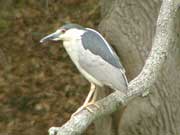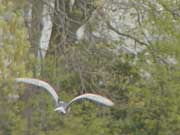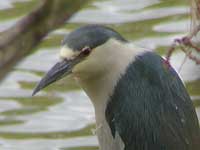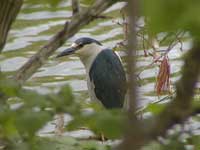
Click any of the images for a slide show of larger versions.
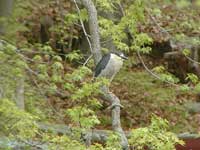 May 14: I was looking to get some more pictures of warblers, so I parked by the fire station in Wanamassa and set off along Wanamassa North Drive where there had been a lot of warblers for the previous few days when my attention was rivetted by the sight of this extraordinary bird. This one was downstream a little from the one Pam and I had seen just about a month ago.
May 14: I was looking to get some more pictures of warblers, so I parked by the fire station in Wanamassa and set off along Wanamassa North Drive where there had been a lot of warblers for the previous few days when my attention was rivetted by the sight of this extraordinary bird. This one was downstream a little from the one Pam and I had seen just about a month ago.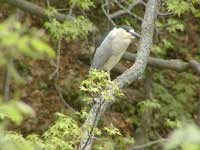 Having learned from experience, I banged off a couple of shots as I approached just in case it flew off before I reached the optimum vantage point.
Having learned from experience, I banged off a couple of shots as I approached just in case it flew off before I reached the optimum vantage point.
It was across the water, but at a point where the water is quite narrow, so I was able to get quite close.
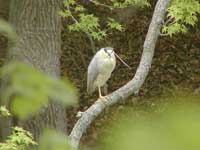 It was when I finally reached said vantage point that I realized the bird was standing on one leg. It is unbelievably stable in that position.
It was when I finally reached said vantage point that I realized the bird was standing on one leg. It is unbelievably stable in that position.
You can see that it noticed me. But I reckon it decided that the water was protection enough because it stayed there unperturbed for quite a long time as I maneuvered myself up and down the bank trying to get slightly better angles.
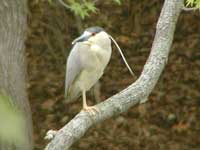 It quickly lost interest in me and continued to observe the its vicinity. I gather that in the normal course of events, these birds forage at night and sleep during the day. I can only imagine that this bird was taking a break during its migration north, which leads to the disappointing conclusion that it won’t be around for long.
It quickly lost interest in me and continued to observe the its vicinity. I gather that in the normal course of events, these birds forage at night and sleep during the day. I can only imagine that this bird was taking a break during its migration north, which leads to the disappointing conclusion that it won’t be around for long.
Notice the white plume blowing in the breeze; the bird has two of them. Apparently, they attract the opposite sex during the mating season.
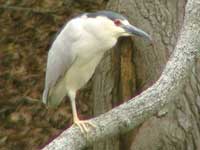 What an amazing picture this bird makes. It’s just about impossible to tell which leg that is!
What an amazing picture this bird makes. It’s just about impossible to tell which leg that is!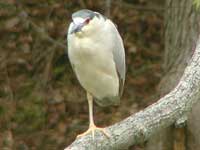 Aha! It’s the right leg. But how on earth can it be balanced? Its center of gravity just doesn’t seem to be over the leg.
Aha! It’s the right leg. But how on earth can it be balanced? Its center of gravity just doesn’t seem to be over the leg.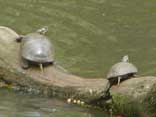 These two were almost directly under the heron. I don’t think they were in any danger, though. I’m surprised that my presence hadn’t sent them scurrying.
These two were almost directly under the heron. I don’t think they were in any danger, though. I’m surprised that my presence hadn’t sent them scurrying.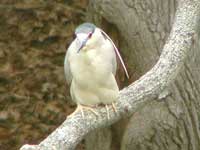 I think this is my favorite shot of the series. It apparently uses both feet when it takes off to fly, but somehow in the process of lowering its left leg, it collapsed on to the branch. The effect is to make it look rather like a penguin.
I think this is my favorite shot of the series. It apparently uses both feet when it takes off to fly, but somehow in the process of lowering its left leg, it collapsed on to the branch. The effect is to make it look rather like a penguin.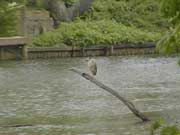
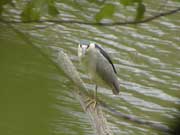
It didn’t fly all that far, so I set off after it. Anyway, if I were going to see any warblers, they’d be just about where the heron had gone and beyond.
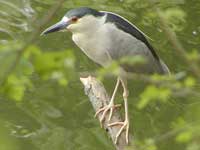 Uh-oh! There’s that second leg again. That means it’s about to fly again. And sure enough, it did, going further down stream towards the warblers.
Uh-oh! There’s that second leg again. That means it’s about to fly again. And sure enough, it did, going further down stream towards the warblers.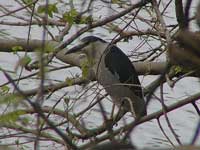 With it sticking to my side of the bank, I was able to get closer, but the trees and brush on the bank made it hard to focus on the bird. This was the third location I’d tracked it to. It didn’t stay here all that long, flying back upstream shortly after I took this picture.
With it sticking to my side of the bank, I was able to get closer, but the trees and brush on the bank made it hard to focus on the bird. This was the third location I’d tracked it to. It didn’t stay here all that long, flying back upstream shortly after I took this picture.